Menu
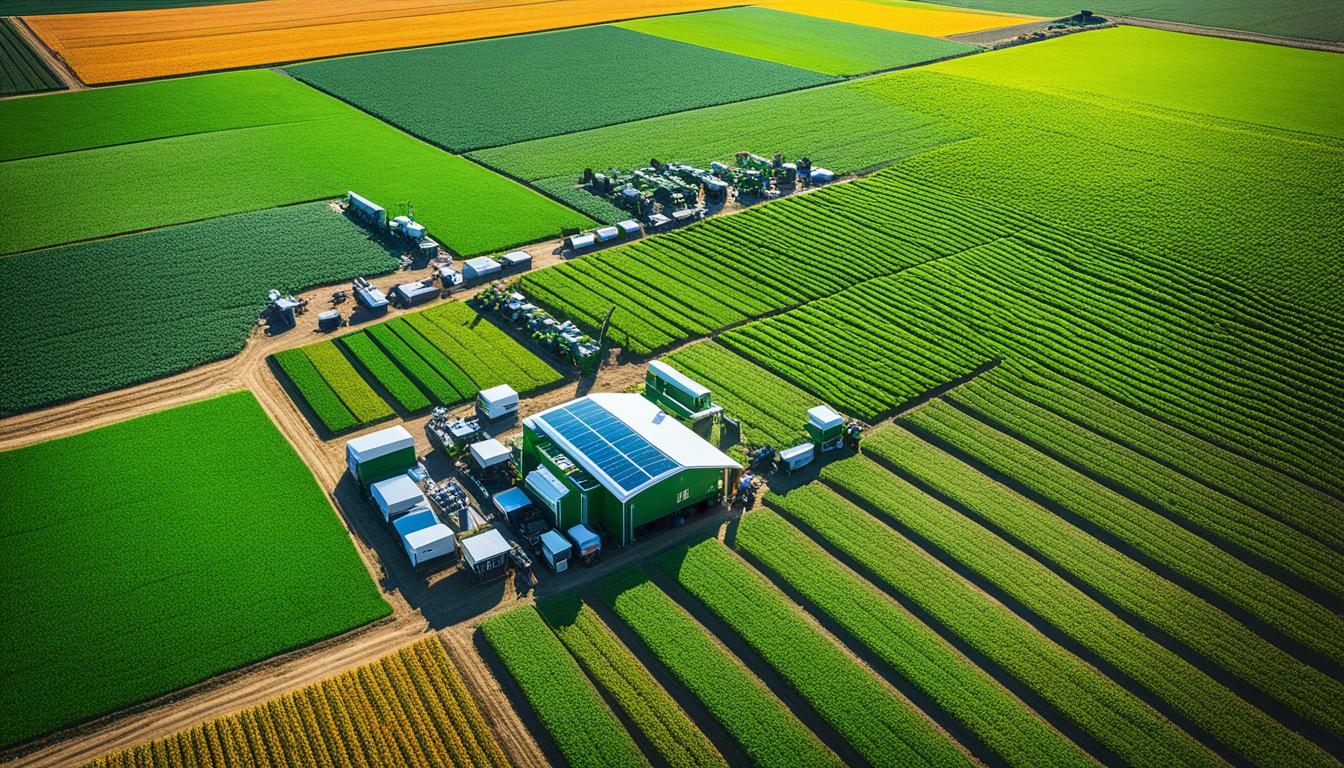
By the end of 2024, nearly 300 million IoT devices will connect to farming. These technologies are quickly changing how we farm. This info comes from the Deloitte Center for Technology, Media, and Telecommunications. I’m excited to tell you how these changes will shape our future.
In 2024, the AgTech market is likely to hit a remarkable US$18 billion in sales. This increase is due to climate change, lack of resources, and rising costs. New tech like AI, IoT, and blockchain play a big role in this growth. They help us grow more food, use resources better, and farm in ways that help the earth. Precision agriculture is at the heart of this change. It uses data to make farming smarter and more eco-friendly.
This push for better technology brings many new inventions. For example, smart irrigation saves water, while AI helps manage stock to cut down on waste. Self-driving machines also help with the lack of farm workers. Companies such as Monarch Tractor and Croft make farm work easier and more efficient. The move towards using data to make smart choices is getting stronger. This shows that technology is vital in farming today.
Precision agriculture in 2024 is helping us make our food production better and more sustainable. Global challenges around food security are getting more serious. Deloitte’s research shows that using technology in farming across the world is becoming vital. This is why we need new and smart ways to grow food without harming the planet more.
With nearly 10 billion people to feed, farming is under more pressure. This is why we’re turning to predictive analytics in farming. Such advanced tools help farmers plan their crops better, leading to higher yields.
| Technology | Benefits | Challenges |
|---|---|---|
| Satellite Technology | Real-time analysis, topography determination, yield estimation | Variability and quality of data |
| Internet of Things (IoT) | Optimal efficiency, weather monitoring, reduction of production risks | Data privacy concerns |
| Artificial Intelligence (AI) | Improved harvest quality, water and energy optimisation | High implementation costs |
| Variable Rate Technology (VRT) | Precision, productivity, risk management | Initial deployment cost |
| Agricultural Robotics | Automated steering, robot swarms, yield increase | Technical complexity |
| Drones | Efficiency, reduced human errors, soil quality assessment | Regulatory approval |
| Big Data & Analytics | Rainfall insights, resource management, efficiency | Data integration |
| Emission Reduction Technology | Carbon capture, storage, emission reduction | Economic viability |
Modern farming technologies don’t just boost yields. They also help us farm in ways that are good for the environment. Using these high-tech systems means we can use our resources more efficiently. This helps make farming stronger and more sustainable. It’s clear that as we face bigger challenges, using predictive analytics in farming will be key.
The agriculture sector is in the midst of a big technological change. The Internet of Things (IoT) is at the heart of this revolution. It brings innovations like smart farming and better ways to manage livestock and track equipment. With IoT, farmers can boost their productivity and make smarter choices.
IoT and smart farming allow for checking crop health in real-time. Thanks to satellite tech, farmers can watch over large farm areas instantly. They can quickly fix issues with fertilisation and irrigation. IoT also helps collect important data for making decisions. This tech makes water use better and ensures nutrients are put on crops efficiently. So, it reduces mistakes and makes crops better.
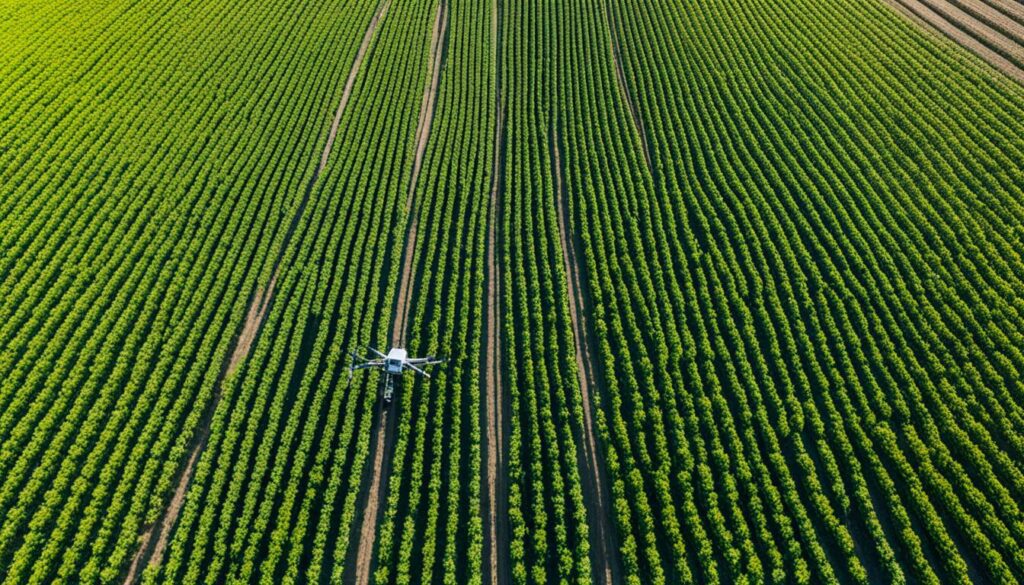
IoT is changing how farmers look after their animals. It gives data to better care for animals and make them work harder. IoT tracks health, how animals eat, and the areas they live in. This data helps farmers plan better and use resources in the best way.
Keeping an eye on farm machinery is easy with IoT. This makes operations run better, avoids breakdowns, and helps with planning when to fix things. Machines are used more efficiently, cutting down on wear and tear and spoiling less. IoT does a lot to help farming run as smoothly as possible.
Predictive analytics is changing how we farm. It gives important insights to make better decisions. By using smart technology to look at data, farmers can plant their crops better. This makes their use of resources smarter and keeps their crops healthier.
One exciting new tool is the use of predictive planting. This technology lets farmers pick the best times and spots to plant their crops. It looks at things like past weather, soil, and more to decide when and where to plant. This approach boosts how much they grow and cuts down on waste.
Examining microclimate data is another big step. It lets farmers see very local conditions, which can be crucial for crop success. This detailed data helps with watering, fertilising, and keeping pests away, customised for their land.
It also helps them find the best places to plant. This way, they save resources and grow more, thanks to cutting-edge technology.
| Region | Top Trends | Active Startups |
|---|---|---|
| India | IoT, Agricultural Biotechnology | High |
| USA | AI, Robotics | Moderate |
| Western Europe | Agri Drones, Precision Agriculture | Moderate |
The move to use predictive analytics marks a big shift towards data-rich farming. With tools like predictive planting and microclimate checks, farmers can do more with less. This leads to a farming future that’s better for the planet and our food.
In 2024, the world of farming is changing fast thanks to new precision agriculture trends 2024. Cutting-edge tech is making farming more sustainable and productive. A big part of this change is the use of more IoT systems.
Digital tools for farming are now more popular. They help farmers manage their fields better and make smarter decisions. For example, devices connected to the Internet of Things (IoT) can keep an eye on things in real time. This helps farmers use data to grow better crops and reduce waste. It’s not just about making farming more efficient. These tools also make sure farming is done in ways that help the environment.
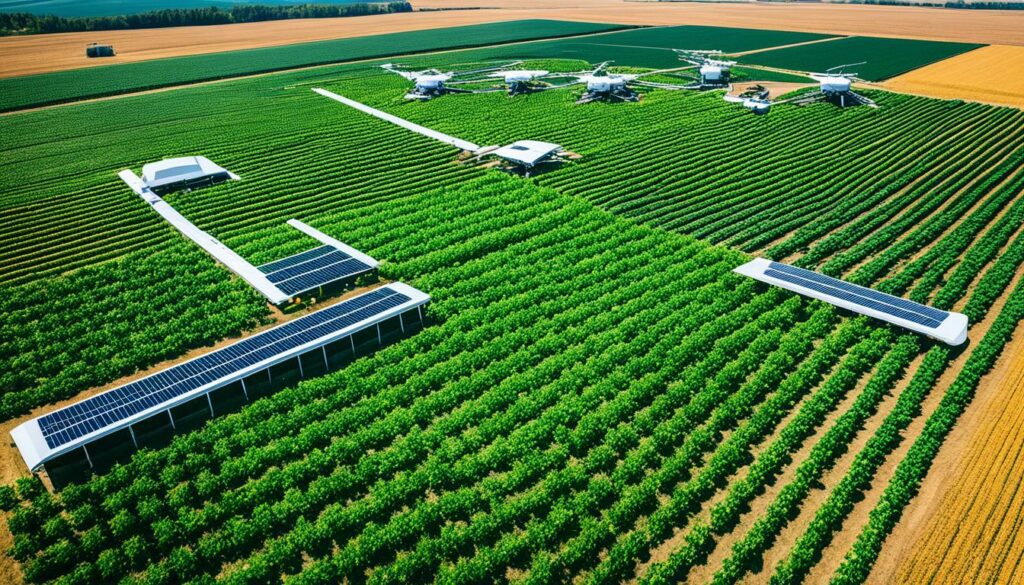
Many companies, new and old, are putting money into these new tech. One example is AI used in managing crops, such as what ICL’s StartUp Agmatix offers. AI can crunch big data to help farmers make choices that boost how well they work. This tech is helping in areas like not having enough workers and making supply chains work better.
People all over the globe want food that’s grown sustainably and organically. They’re focused on health and keeping the planet safe. Mintel’s latest report says this focus on doing things right for the world is key in 2024. Buying food from local sources is also becoming more popular. This helps deal with issues in how food gets from farms to our plates and makes things clearer for shoppers.
To fight the bad effects of food waste, we’re seeing new ideas pop up. There are now smart ways to store food and apps to share food we don’t need. These are making a big difference in wasting less food. Also, more people are choosing to eat proteins that come from plants. This choice is good for our health, the way we treat animals, and the planet. It means farmers are turning more to growing crops like soybeans and legumes.
The change happening because of precision agriculture trends 2024 and smart farming innovations is not small. It’s making us think about farming in new ways. To keep this going, we need to keep on investing in new farming technologies. This is how we’ll keep up with the growing need for food around the world.
Now, more than ever, it’s key for farmers to use methods that are kind to the planet. Turning to sustainable farming helps soil health, traps carbon, and adds more plant and animal life. This not only makes crops better but fights against global warming too.
Crop rotation and no-till farming are showing big results in making more food without harming nature. These methods work with the earth to give it back what it needs. They make the ground healthier, which then grows better crops. This shows the farm sector is serious about keeping on farming for many more years, without hurting the planet.
New tech is helping farmers to be better for the environment. Drones, high-tech sensors, and clever computer programs are making it easier for them to use water and fertilisers more carefully. This cuts down on waste and moves farming towards a smarter future. Using solar power is also getting more common, helping farms to be greener. These new ways are crucial for farming to keep growing lots of food, but in a way that’s much kinder to the Earth.
Data-driven farming is now key for better farming. It uses smart data tools to make farming more precise. Farmers can see how to use resources better and get healthier crops.
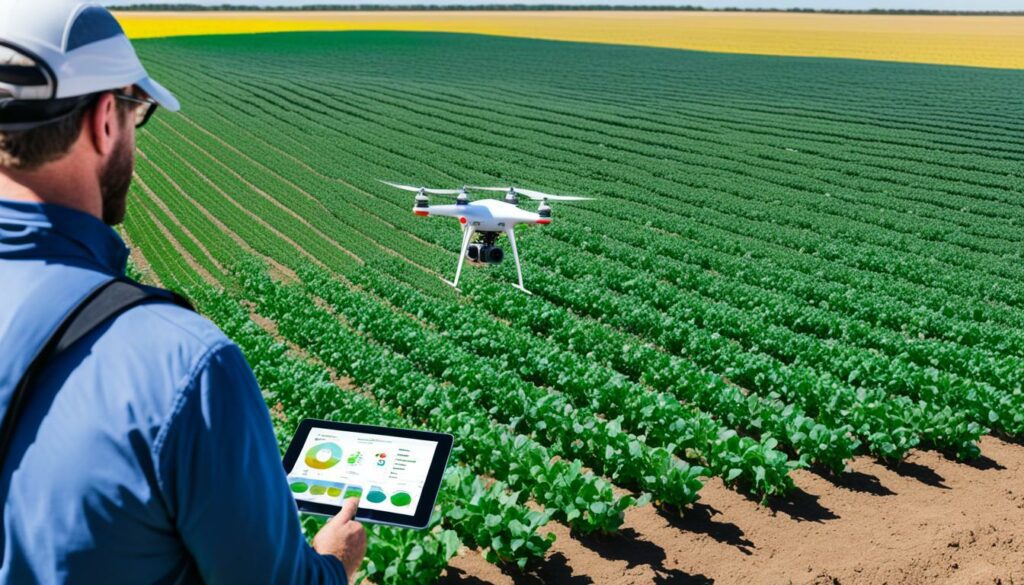
Big data is changing farming for the better. It lets farmers understand their land deeply. They can make smarter choices and farm more productively.
Watching crops in real-time changes everything. Farmers can stop problems early, like pests or not enough water. This keeps their crops healthy and their farms green.
AI in storing and moving food also helps reduce waste. This shows how important using data in farming is. It makes farming more efficient and kind to the planet.
If we use data and watch things closely, farming can be better. We save resources and get healthier crops. The future of farming is looking bright.
Robotic farming technologies will change agriculture by 2024. They boost efficiency and are eco-friendly. They tackle labour shortages and do jobs with great accuracy.
Autonomous tractors are transforming farm work. They operate by themselves, doing tasks like ploughing and seeding perfectly. This tech cuts the need for people at work and saves money.
Automated weeding is a big step in farming. These machines can find and get rid of weeds with little use of chemicals. As a result, they cut the need for herbicides and help crops grow better.
| Features | Autonomous Tractors | Automated Weeding Systems |
|---|---|---|
| Labor Reduction | High | Moderate |
| Operational Precision | Unmatched | Advanced |
| Chemical Use Reduction | Minimal Impact | Significant |
| Sustainability | Enhanced | Boosted |
Using these technologies makes farming more efficient and greener. They build on the latest in precision farming. This is key for handling the future needs of farming well and responsibly.
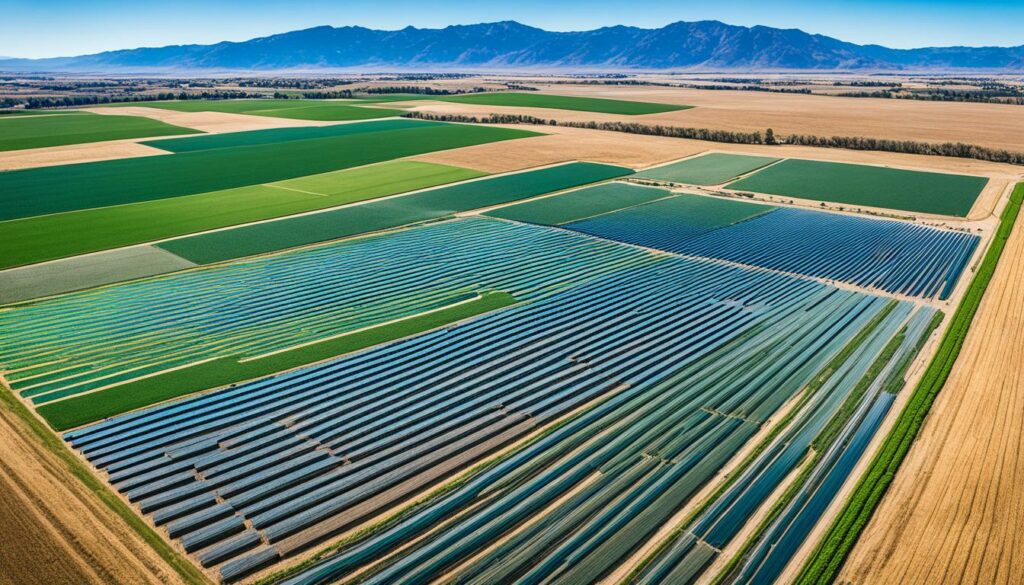
Precision irrigation systems are a key advancement in AgTech. They have roots in the field of precision agriculture. This area has grown since the 1980s, with advances like variable rate fertilisers from Dr. Pierre Robert. These systems are key for saving water. They use approaches like drip and micro-sprinkler irrigation, getting water straight to plant roots. This boosts water efficiency by up to 70%.
A big part of these systems is their use of high-precision sensors. These sensors track soil moisture in real time. This helps farmers use water well, reducing waste. This real-time monitoring is vital for the success of these systems. It makes sure every crop gets just the right amount of water it needs to grow well.
These systems also fit in with key trends in the irrigation industry up to 2024. This includes things like remote monitoring and smart controllers. This shows a move towards more sustainable farming. Innov8.ag is a US startup using data to make irrigation better. It shows how AgTech is key in boosting agriculture’s productivity and reducing its impact on the environment.
Moreover, precision irrigation is helping the global market for precision farming grow. In 2023, this market brought in USD 10.5 billion. Experts predict this number will keep growing, reaching USD 33.2 billion by 2033. This growth highlights precision irrigation’s importance in making farming more efficient and sustainable worldwide.
Finally, these systems benefit from the progress in predictive analytics and machine learning in agriculture. These technologies turn huge amounts of data into useful advice for farmers. This helps them to use water and other inputs in a smart way, boosting their harvests. There is a solid link between high-tech solutions and the practical needs of farming.
| Year | Precision Farming Market Revenue (USD Billion) |
|---|---|
| 2023 | 10.5 |
| 2024 | 11.8 |
| 2025 | 13.2 |
| 2026 | 14.8 |
| 2027 | 16.6 |
| 2028 | 18.7 |
| 2029 | 20.9 |
| 2030 | 23.5 |
| 2031 | 26.4 |
| 2032 | 29.6 |
| 2033 | 33.2 |
Generative AI is changing AgTech for the better. It’s making decisions smarter, saving resources, and cutting costs big time. This means the future of farming is becoming a reality with AI tools and digital crop advisors.
Farmers can now manage crops better with AI. They get real-time data and predictions, which help with planting, checking on crop health, and deciding where to use resources. The USDA says AI in farming is key to tackle high production costs and climate change. By 2036, farm data might grow more than 800%. Generative AI is critical in handling and making use of this huge amount of information.
Digital crop advisors are another big step forward. They use AI to suggest what crops to grow by looking at soil, weather, and past crops. This can boost yield, lower waste, and meet the 2024 demand for eco-friendly food, says a Mintel report. Also, they help with farming that cares for the soil and the whole ecosystem.
So, generative AI in AgTech is much more than just doing tasks on its own. It’s helping create a farm future that’s sustainable and effective.
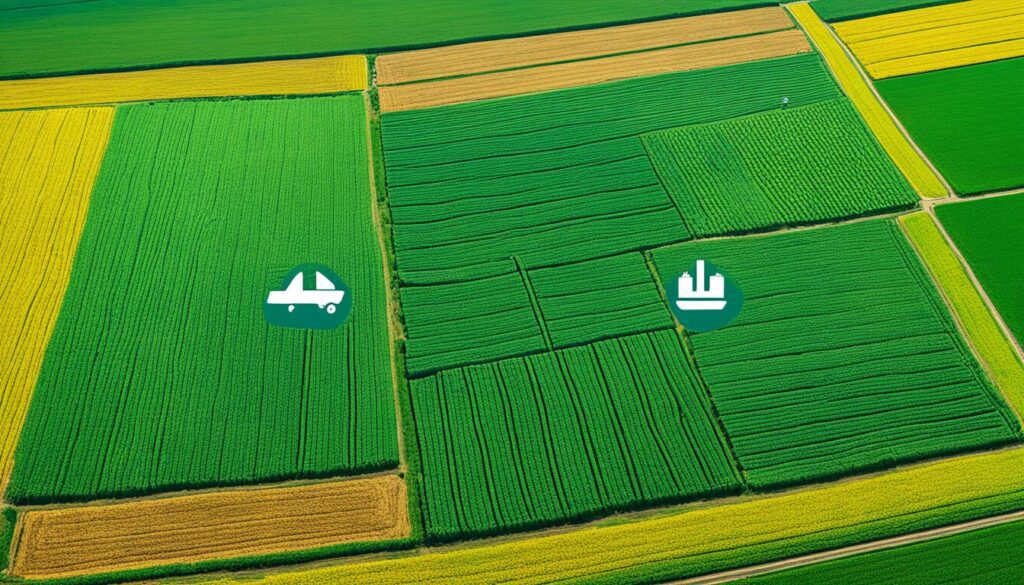
In agricultural R&D, digital twins are making a big impact. By 2024, these models will greatly improve field trial processes. From 2010-2014, developing a new crop protection product cost nearly $286 million. About $47 million of that was used for field trials. This shows why making this stage more efficient and cost-effective is crucial. Digital twins let us virtually simulate whole field trials. This cuts down on time, effort, and costs linked to traditional ways.
Using digital twins can also speed up the launch of new agricultural products. This is key as innovation in agriculture that relies on data is growing. By 2036, farming data collected is expected to surge by over 800%. This will need top-notch cloud solutions to handle the big data effectively. Such solutions have proven they can reduce trial duration and spending. They also increase the trial’s scope.
Digital twins are valuable not just for field trial planning but also for improving AgTech tools. These tools help deal with tough natural conditions and supply chain issues. With digital twins, researchers can simulate various farming scenarios and predict results with greater accuracy. This makes crop development more efficient and resilient. Such work is critical for sustainability and food security. By using digital twins, the agricultural industry is stepping up its game. It’s making way for more innovative and practical agricultural solutions.
| Year | Data Collected on Farms | Cost Allocation for Field Trials | Impact of Digital Twins |
|---|---|---|---|
| 2010-2014 | Baseline | $47 million (16% of $286 million) | Traditional physical trials |
| 2024 | Increased significantly | Reduced through digital twins | Virtual simulation, cost-effective |
| 2036 | 800% increase | Optimised and reduced further | Advanced integration, faster development |
To sum up, the use of digital twins is changing how we do field trials drastically. It’s offering clearer insights, reducing costs, and making research faster. This change is crucial now, as we tackle growing global farming issues and work towards a greener and more efficient future.
Challenges in getting enough farm workers are growing. As older workers retire, young people are less keen to join. But, new tech breakthroughs are here to help. They promise to make farming easier with less hard work needed.
Automation is changing traditional farming tasks, making them precise and efficient. Monarch Tractor created self-driving tractors with smart AI. These tractors handle a lot of the work, use resources better, and farm more accurately. This means less need for people to plough, plant, or harvest, making things faster and better. Also, Croft has a method to cut over 50% of the time spent on paperwork for farms, making life easier.
Drones bring big benefits that can help with farm work. They’re good for checking fields from the air and treating crops in hard-to-reach areas. So, farmers can see how their crops are doing and put water and fertiliser where they’re really needed. This cuts waste and boosts farm efficiency. Using drones is a win for both saving resources and farming smarter.
| Technology | Company | Benefits |
|---|---|---|
| Autonomous Tractors | Monarch Tractor | Reduced workload, Optimised resource use |
| Automated H-2A Process | Croft | Reduced administrative time |
| Drones | Various Companies | Aerial surveying, Targeted crop treatment |
Farms can solve their labour issues by using more automation and drones, making farming last and grow better.
Blockchain technology is changing the way we track food, making it safer to eat. It uses a clear and safe ledger to record each step of a product’s journey. This makes sure food is safe from where it’s grown to when we eat it. It also means we can quickly find where a problem started if there’s an issue.
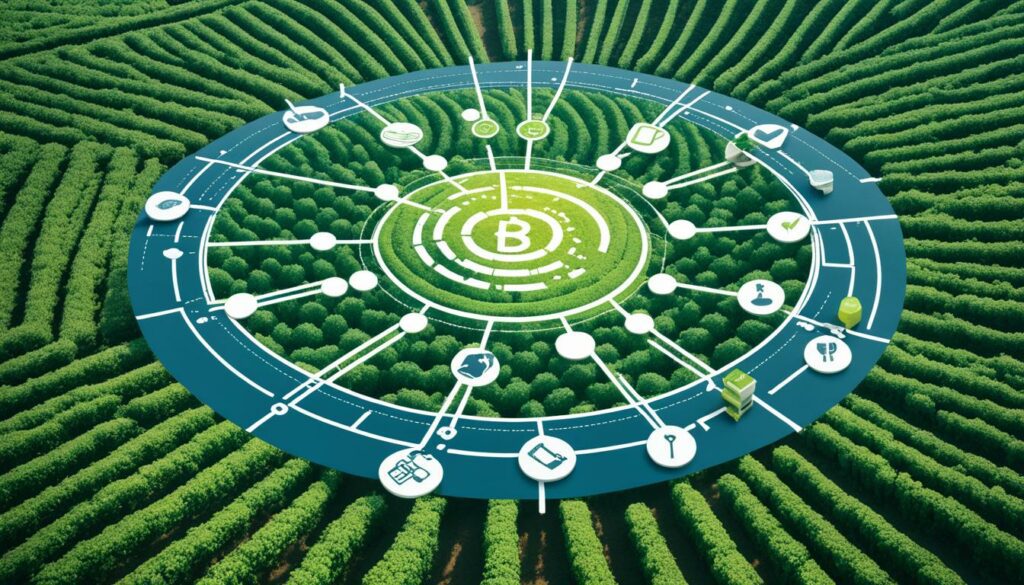
With blockchain, food gets safer. Big names like Walmart and Nestlé are using it to watch over their food from start to finish. This quick look at a product’s journey helps solve any safety problems fast. It makes people feel more confident about what they’re eating.
Blockchain lets us watch food move in real time and keep it safe. It makes a record that can’t be changed. This helps check that every part of making food meets very high safety rules. So, we all get to eat safer food.
The rise of cloud solutions is changing how we manage and look at farm data. This change is key for bringing new ideas and making farms better. Cloud tech is useful for things like managing crops, checking soil, and tracking how much we grow. These are all key for modern farming ways.
Cloud solutions in farming let us see data in real time. This means we can do trials faster and for less money. We can also do more tests. They are super important as we need to make 70% more food by 2050 for a world with 9.1 billion people.
Cloud platforms help different experts and farmers work together better. They share what they know and data instantly. This helps everyone make smarter choices quickly. Working together is crucial to deal with big challenges like climate change and not enough resources.
The precision farming market was worth $9.8 billion in 2022. By 2032, it’s expected to grow to over $34.01 billion. This growth shows we’re moving towards using more intelligent farming technology.
In Canada, the precision agriculture sector is big at $870 million. Its value is set to grow by 11.8% each year. People want the advanced tools that cloud tech offers. This highlights the vital role of cloud solutions in farming today.
Using cloud solutions benefits farming by making it more efficient, eco-friendly, and creative. These techs make work smoother and help handle lots of data. This gets our farms ready for the big challenges ahead.
The future of farming is all about embracing new technologies. These tech advances focus on being eco-friendly and helping farmers grow more food. They aim to overcome climate change effects and using fewer resources.
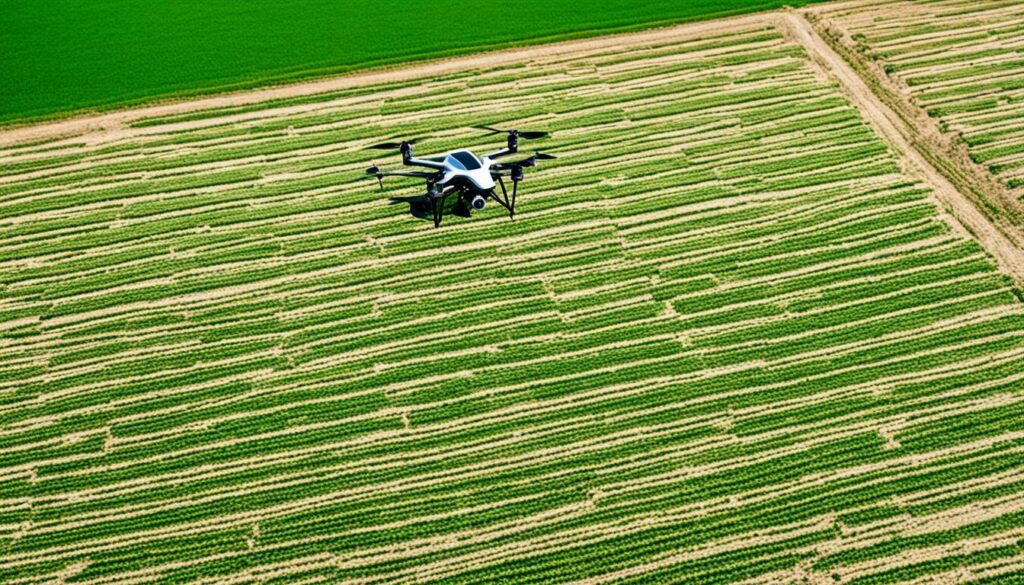
Satellite technology is key in future farming. It lets farmers look at big areas in real-time. This helps fix problems quickly, like where crops need more water or fertilizer. The Internet of Things (IoT) also plays a big part. It helps have better control over farming and how livestock are taken care of. This makes decisions smarter and helps the environment, too.
New tech is the heart of farming in 2024. Artificial Intelligence (AI) makes sense of data from the farm. It helps to use water and energy better. Variable Rate Technology (VRT) is also important. It helps put water and nutrients exactly where they’re needed. This cuts down on mistakes and boosts farm yields.
Robots and automation also play a part. They help increase harvests by using data and carrying out tasks. Drones are key for checking on plants, controlling pests, and keeping an eye on soil. Big data and analysis give detailed information on things like rain, what crops need, and the water system. This helps make farming more in tune with the climate.
Reducing emissions is a must for future farming. Using tech to capture and store carbon helps the environment. These tech solutions are vital for lasting agriculture. They help save resources and grow more food efficiently.
The journey through precision agriculture trends shows a bright future. It links technology and sustainability strongly. My research, with support from the Deloitte Center for Technology, Media & Telecommunications, proves that using automated irrigation and GPS in farming is now not a far-off dream. These tools help farmers manage water better, cut down waste, and check soil health easily.
Technologies like AI, IoT, and blockchain are changing how we farm. For example, Monarch Tractor has tractors that use AI to work on their own. This helps with fewer workers and is more efficient. Also, Croft’s tech for managing seasonal workers cuts time spent on admin in half. The use of RFID and blockchain ensures food is safe, with easy tracking for everyone.
Financing for agriculture is also getting better with these technologies. They make transactions safer and offer more financial services to farmers. Looking forward, using these techs in farming promises a future where we farm better with fewer resources. This is key to feeding more people without harming the environment. The future of farming in 2024 looks like it will be precise, efficient, and M-tech powered.
In 2024, precision agriculture is focusing on IoT tech, smart farming, and sustainability. These trends will make farming more productive and eco-friendly.
With IoT, farmers can watch over their crops in real time. This makes farming more precise. IoT also collects data on soil and weather. This lets farmers use their resources smartly.
IoT improves taking care of livestock by giving real-time data. This helps in looking after animals better. It also makes farm management more efficient.
Predictive analytics helps farmers in making smart decisions. They use data to pick the best times and places to grow crops. This boosts harvests and saves time.
This year, smart farming is getting more AI and IoT tech. It’s also using robots more. These changes are tackling the lack of farm workers and making farming more sustainable.
Sustainability is being boosted by using new farming methods and tech. This includes being smart about watering and fertilising. These efforts are helping the soil and environment, and encouraging more nature on farms.
Data-driven solutions are changing farming by allowing real-time checks on crops. This helps farmers to act quickly when needed. It also improves growth and plant health.
Robot farming is changing things by doing tasks without much help. For example, they plough and get rid of weeds. This saves time and makes farms more eco-friendly.
Precision irrigation saves water and makes farming smarter. Water and nutrients go straight to the plant roots. This cuts down on waste and helps farmers save money.
Generative AI is making AgTech more effective and cheaper. It uses big data to improve how farms are run. This makes farming more flexible, even with changing weather.
Digital twins help plan farming experiments without going into the field. This saves money and time. It makes developing new farm products and getting approvals easier.
Technology in farming is helping do jobs without as many people. This includes using drones to check crops and spray them. It makes farms run more smoothly and accurately.
Blockchain makes it easy to follow food from the farm to the table. It keeps a safe, clear record of every step. This stops bad food getting to people and makes food safer.
The cloud helps store and look at farm data. It supports growing and looking after crops. This way, farmers can work together better and come up with new farm ideas.
In 2024, farming will rely more on new tech to be both efficient and eco-friendly. Using IoT, AI, and the cloud together will make farming smarter. This helps meet food needs while protecting the planet.